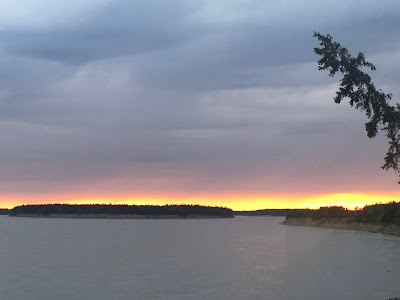2022 June 18 to 26
We covered the road from the Dempster Junction to Stewart Crossing and, from there, to Carmacks on our way north, so this was familiar ground. We visited Ethel Lake to camp one night. We had vaguely expected it to be a deserted lakeside campsite, given the distance from the highway on an unsurfaced track, however, it proved to be jammed with humans and mosquitoes.
Faro was quiet, a town built for a mine that no longer operates. There, we found our way to the Mount Mye Sheep Centre although we saw no sheep, and explored the road to the mine seeing three porcupines out for the evening.
We camped at Johnson Lake, and this was the point at which the insect population made itself really evident. There had been an increasing number of mosquitoes in recent days, however, we had successfully stayed ahead of them as we worked our way north. But now the mosquito season was underway: a combination of repellent and a fire was used to keep them at bay, however, the mosquitoes were aggressive nonetheless!
Continuing east we enjoyed Lapie Canyon and then Ross River, where the road north was closed due to high water, and the suspension bridge was also closed. Several points of interest were also closed, so we had to continue eastward. We made stops at Hoole River, Finlayson Lake, and Simpson Lake before camping for the night at Watson Lake.
From here, we took the Highway north, heading for the Great Slave Lake region via this less frequently traveled route. We stopped at Coal River and enjoyed Liard River Hot Springs, reminiscent of similar stops in Iceland. From here on, we saw more wildlife than we had seen in a while – black bears, bison, caribous, porcupines, and wild sheep. The next several days we had heavy rain on the road, but arriving at Fort Nelson it turned torrential, luckily, we stocked up there for the next stage of the trip.
Heading north on the Liard Highway we encountered bison in larger numbers, also encountered black bears, and we were excited to see a lynx on the side of the road, which watched us long enough to be captured on an image or two.
Our next objective was Wood Buffalo National Park, the largest national park in Canada, and where we hoped to see Wood Bison. Before heading east we stopped in Hay River for coffee at the excellent Big Lake Eatery & Café, to which we returned on our way back. Wood Buffalo National Park has the benefit of being huge and having large numbers of bison; unfortunately, the density of bison per unit area allowed us to see only one herd, a very long way off, from the viewpoint over the salt plains, which is itself a beautiful spot. We walked down to the plains and then returned to head for Fort Smith.
We then traveled northwards. After having seen no bison in Wood Buffalo National Park (at least none other than at great distance), we were pleased to encounter many bison on this route, initially a few in the Mackenzie Bison Sanctuary and then larger numbers in the Wood Bison Protection Area further north.
Finally, we arrived at Yellowknife, the capital of Northwest Territories, and in relative terms a major center, although not the highest in population. This was to be our base for the ensuing week.
Our next stages of the trip:
We’ll spend the week in Yellowknife, then start southbound to Northern Alberta, then into British Columbia again to head back to Vancouver for the next chapter of the trip.
Hugs
Alan & Marce




















No comments:
Post a Comment